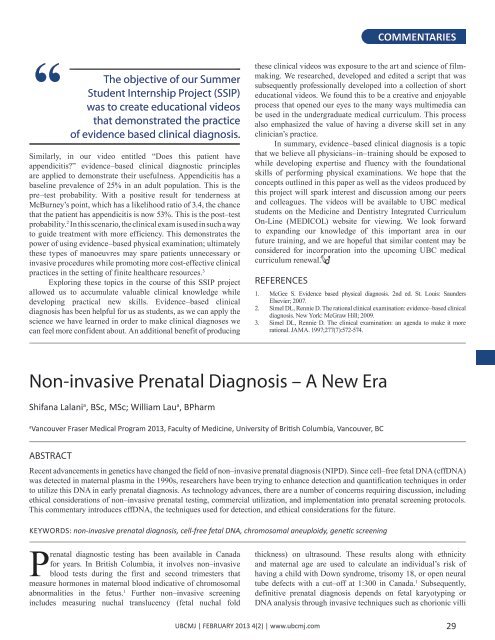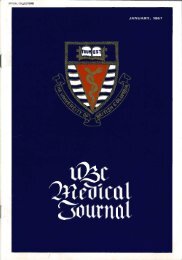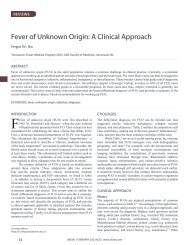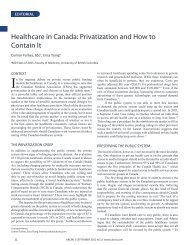Download full PDF - UBC Medical Journal
Download full PDF - UBC Medical Journal
Download full PDF - UBC Medical Journal
Create successful ePaper yourself
Turn your PDF publications into a flip-book with our unique Google optimized e-Paper software.
COMMENTARIES<br />
“<br />
The objective of our Summer<br />
Student Internship Project (SSIP)<br />
was to create educational videos<br />
that demonstrated the practice<br />
of evidence based clinical diagnosis.<br />
Similarly, in our video entitled “Does this patient have<br />
appendicitis” evidence–based clinical diagnostic principles<br />
are applied to demonstrate their usefulness. Appendicitis has a<br />
baseline prevalence of 25% in an adult population. This is the<br />
pre–test probability. With a positive result for tenderness at<br />
McBurney’s point, which has a likelihood ratio of 3.4, the chance<br />
that the patient has appendicitis is now 53%. This is the post–test<br />
probability. 2 In this scenario, the clinical exam is used in such a way<br />
to guide treatment with more efficiency. This demonstrates the<br />
power of using evidence–based physical examination; ultimately<br />
these types of manoeuvres may spare patients unnecessary or<br />
invasive procedures while promoting more cost-effective clinical<br />
practices in the setting of finite healthcare resources. 3<br />
Exploring these topics in the course of this SSIP project<br />
allowed us to accumulate valuable clinical knowledge while<br />
developing practical new skills. Evidence–based clinical<br />
diagnosis has been helpful for us as students, as we can apply the<br />
science we have learned in order to make clinical diagnoses we<br />
can feel more confident about. An additional benefit of producing<br />
these clinical videos was exposure to the art and science of filmmaking.<br />
We researched, developed and edited a script that was<br />
subsequently professionally developed into a collection of short<br />
educational videos. We found this to be a creative and enjoyable<br />
process that opened our eyes to the many ways multimedia can<br />
be used in the undergraduate medical curriculum. This process<br />
also emphasized the value of having a diverse skill set in any<br />
clinician’s practice.<br />
In summary, evidence–based clinical diagnosis is a topic<br />
that we believe all physicians–in–training should be exposed to<br />
while developing expertise and fluency with the foundational<br />
skills of performing physical examinations. We hope that the<br />
concepts outlined in this paper as well as the videos produced by<br />
this project will spark interest and discussion among our peers<br />
and colleagues. The videos will be available to <strong>UBC</strong> medical<br />
students on the Medicine and Dentistry Integrated Curriculum<br />
On-Line (MEDICOL) website for viewing. We look forward<br />
to expanding our knowledge of this important area in our<br />
future training, and we are hopeful that similar content may be<br />
considered for incorporation into the upcoming <strong>UBC</strong> medical<br />
curriculum renewal.<br />
REFERENCES<br />
1. McGee S. Evidence based physical diagnosis. 2nd ed. St. Louis: Saunders<br />
Elsevier; 2007.<br />
2. Simel DL, Rennie D. The rational clinical examination: evidence–based clinical<br />
diagnosis. New York: McGraw Hill; 2009.<br />
3. Simel DL, Rennie D. The clinical examination: an agenda to make it more<br />
rational. JAMA. 1997;277(7):572-574.<br />
Non-invasive Prenatal Diagnosis – A New Era<br />
Shifana Lalani a , BSc, MSc; William Lau a , BPharm<br />
a<br />
Vancouver Fraser <strong>Medical</strong> Program 2013, Faculty of Medicine, University of British Columbia, Vancouver, BC<br />
ABSTRACT<br />
Recent advancements in genetics have changed the field of non–invasive prenatal diagnosis (NIPD). Since cell–free fetal DNA (cffDNA)<br />
was detected in maternal plasma in the 1990s, researchers have been trying to enhance detection and quantification techniques in order<br />
to utilize this DNA in early prenatal diagnosis. As technology advances, there are a number of concerns requiring discussion, including<br />
ethical considerations of non–invasive prenatal testing, commercial utilization, and implementation into prenatal screening protocols.<br />
This commentary introduces cffDNA, the techniques used for detection, and ethical considerations for the future.<br />
KEYWORDS: non-invasive prenatal diagnosis, cell-free fetal DNA, chromosomal aneuploidy, genetic screening<br />
Prenatal diagnostic testing has been available in Canada<br />
for years. In British Columbia, it involves non–invasive<br />
blood tests during the first and second trimesters that<br />
measure hormones in maternal blood indicative of chromosomal<br />
abnormalities in the fetus. 1 Further non–invasive screening<br />
includes measuring nuchal translucency (fetal nuchal fold<br />
thickness) on ultrasound. These results along with ethnicity<br />
and maternal age are used to calculate an individual’s risk of<br />
having a child with Down syndrome, trisomy 18, or open neural<br />
tube defects with a cut–off at 1:300 in Canada. 1 Subsequently,<br />
definitive prenatal diagnosis depends on fetal karyotyping or<br />
DNA analysis through invasive techniques such as chorionic villi<br />
<strong>UBC</strong>MJ | FEBRUARY 2013 4(2) | www.ubcmj.com<br />
29










